Many thanks to SWLing Post contributor, 13dka, for the following guest post:
A review of the XHDATA D-808
by 13dka
After all the recent buzz about the new XHDATA D-808 I had to get one. I got mine 3 weeks ago and I couldn’t help comparing it a lot with my PL-660. The PL-660 lends itself to such a comparison: it turned out to be the most sensitive shortwave portable with SSB in some comparison tests, so it became some kind of benchmark radio for this class of receivers and it has the same coverage as the D-808. Here are my findings, let’s start with the important stuff:
Performance
I always try new receivers at my favourite listening post at the (German) North Sea shore, many of you know how beneficial such a location is for DXing. My favorite spot there is far away from any houses, power lines or other interference sources on the land side, so besides some sheep-made noise the man-made noise is as low as it gets, measured less than -130dBm (which is the receiver noise) on a 1/2 lambda dipole above 10 MHz.
At the same time the close proximity to the water results in somewhat boosted signals, so I can assess both reception quality at the lowest sensitivity threshold and behavior with strong signals. Sometimes it lets me find quirks that would go unnoticed anywhere else.
Here are my findings with the D-808:
Sensitivity
Longwave
Since users in the US have little ways to test that, let me assure you that all rumors you may have heard about a deaf longwave are perfectly true: the European LW broadcast band is pretty much not existing on the D-808. All those reports (e.g. many to find in Amazon reviews) indicate that really all D-808 are affected. The PL-660 is known to be very deaf on LW as well but it picks up a few stations in the evening, only some of them leave a faint clue on the D-808 and it can’t pick up BBC 4 on 198kHz even at night.
The signal meter indicates that it gains some sensitivity only above 300kHz, but from there it quickly starts to beat the PL-660 – during the day I can hear all of the local NDBs, something I can’t say about the PL-660.
AM broadcast band
This continues throughout the AM broadcast range – best tested during the day and on early evenings, the D-808 lets me ID weak stations that are just not there (yet) on the PL-660. Being noticeably better than the Tecsun, I then compared it to my old Grundig Satellit 400 (which has an average sensitivity on MW) and the D-808 matches its performance perfectly. So perhaps it’s not exactly a MW DX machine with just its internal loopstick but it performs well enough to make the band enjoyable.
Trying that at night and indoors shows why the right time and a low-noise location (or alternatively proper test equipment) are so important for such comparisons: any weak station sticking out of the distant and local QRM there is not as weak as it sounds anymore, both QRM and wanted signal are now well above the sensitivity thresholds of both radios and so SNR is defined only by the QRM, not the receiver. That means both radios falsely appear to have exactly the same sensitivity.
Shortwave
Notwithstanding some duds, the PL-660 is known to be a little sensitivity monster on shortwave. When I don’t feel like putting up wires etc. for my SDR, I just take the Tecsun to the beach and through the years I own it, I’ve logged plenty of true DX (JA, VK/ZL or WWVH on a regular basis) with it there, just using the telescopic whip.
Only below 3 MHz it’s not all that great on the whip, and that’s where the D-808 beats it – listening to top band (160m) hams works surprisingly well for a 25 inch whip. Between 3 and 30MHz the D-808’s sensitivity appears to be almost on par with the PL-660, the PL-660 often wins in terms of intelligibility at the “minimum discernible signal” (MDS) threshold. For example, on a day with bad conditions Gander Radio on 6604kHz USB had a barely audible signal on both radios. But I could occasionally decipher some words on the Tecsun that didn’t make it through the noise on the D-808. These photo finish victories for the PL-660 can be observed across most bands, but it needs ridiculously weak signals to spot the difference.
This difference is partly due to the fact that the D-808 seems to be a tad more noisy and partly owed to the better speaker of the PL-660. But the PL-660 also sports the often frowned upon “soft muting” feature, thus creating an impression (or should I say illusion?) of a pretty quiet receiver. I find it hard to tell whether the D-808 is really noisier than the PL-660, or just lacking this permanent noise reduction. I think this feature potentially even increases intelligibility on SSB a tiny bit, but on AM it’s just disturbing and makes the Tecsun lose its sensitivity advantage. Bottom line is that the D-808 is at least very close to the PL-660 in terms of sensitivity on shortwave and I find that quite remarkable.
FM
Both receivers are pretty identical in FM performance on their whip antennas. Sensitivity is good enough to pick up high-power stations more than 100km away in times without any elevated conditions. Both receivers don’t need much signal to make a station intelligible, so when conditions improve a tiny bit (“marginal” indications on the Hepburn Index map) the band already gets populated accordingly. One difference is the coverage: the PL-660 can be switched to cover the Japanese FM band (76-108MHz) only, the D-808 covers the old OIRT band (64-108MHz) on top. What makes the D-808 the winner is its RDS/RDBS capability and the size, it certainly has the sensitivity needed for some ad-hoc FM-DX when you find yourself bored on a hill or in sudden tropo conditions.
By the way: RDS gets decoded sufficiently fast and starts to show on signals with an SNR of at least 12dB (see the bit about the RSSI/SNR meter below). If the station transmits date information it will set the clock automatically, but when you go on a hunt for stations it may receive some garbage data that resets the clock to a wrong time. It may be best to turn on the automatic only occasionally to set the clock, then turning it off again.
Air Band
The D-808 is at least as sensitive as my Alinco DJ-X11 scanner and skunks the rather deaf Tecsun in this band. Unlike the PL-660 and most other small receivers covering that band it has a squelch, which is by the way active on all bands.
What it lacks is the new 8.33 kHz channel spacing, the “Fast” tuning step is still 25 kHz (“Slow” is 1 kHz) and the scan searches the band in 25 kHz steps as well, so I have to tune in the new channels manually. But while it lacks the new spacing, it absolutely has the selectivity for it – the AM filters are all available on the air band as well and even the widest one is still good enough to separate adjacent channels sufficiently. My 6 times more pricey Alinco has the new 8.33 kHz channels but it can’t separate them at all.
The D-808 is a great air band receiver!
Selectivity
The PL-660 has 2 (I think unspecified) ceramic IF filters for SW, which are doing a good job serving 90% of all typical purposes for such a radio. The D-808 on the other hand utlizes the DSP for IF filtering and offers whopping 11 different bandwidths (6 on AM and 6 for SSB), this is even more than the PL-880! This sold the D-808 to me the most, for example I like to improve my very poor CW listening skills every so often, and always having an even narrower filter up the sleeve can save otherwise hopeless DX reception in the ham and broadcast bands. But are they any good?
SSB: 500 Hz, 1 kHz, 1,2 kHz, 2,2 kHz, 3 kHz, 4 kHz
The 500 Hz “CW filter” seems to have a rather slow cutoff, unlike a true 500 Hz CW-filter it leaves voice communication almost intelligible. Still beats trying to hear CW through a regular SSB filter though! The 1 kHz filter seems to be the only one with an offset lower skirt (=less bassy sound), which can be useful in some cases. I’m not quite getting the purpose of the 1.2 kHz filter, I think I’d prefer a 1.8 kHz filter for a step between 1 and 2.2 kHz. The 1.2 through 4 kHz filters have the steeper cutoff you’d expect from DSP filtering and serve their purpose pretty well. In the “Gander Radio” example above, the narrow filter on the PL-660 couldn’t keep 4XZ’s CW signal on 6607kHz in check, while the D-808’s 2.2kHz filter eliminated the CW signal completely. I’d still take the bandwidth figures with a grain of salt though.
AM: 1 kHz, 1,8 kHz, 2 kHz, 2,5 kHz, 3 kHz, 4 kHz, 6 kHz
Oddly, the published bandwidth for the AM filters seem to be “audio bandwidth” (or “per sideband”) figures rather than IF-bandwidths, so they equate to classic IF filters with 2/3,6/4/5/6/8 and 12 kHz bandwidth. The only overlap is 4 kHz, hence I say it’s 11 different bandwidths, not 10. I think these AM bandwidths should cover all requirements that might come up, on top of those you can try ECSS reception with the SSB filters.
SSB Reception
On pretty much all of the tiny shortwave portables, SSB reception comes with some tradeoffs and the D-808 is no exception. When the PL-880 hit the market a few years ago, the amount of filters for SSB offered by the Si4735 DSP raised my hopes for improved SSB, but unfortunately the D-808 has the same problem that kept me from buying the PL-880 back then, and some on top:
AGC distortion
Like the PL-880 (at least some of them), the D-808’s AGC has a way too slow attack rate, the first portion of any strong SSB/CW signal is distorted before the AGC levels back, and it increases gain fast enough that even short talking (or keying) pauses make the next syllable distorted again. This seems to plague most (if not all) Si4735-equipped radios, so that might be actually a bug of the DSP.
Tuning
The chuffing noise is making tuning through the band quite bad in SSB mode, it’s even worse than the early digital “keypad”-style radios in the 1980s: every tuning step is causing first a short muting of the signal, then audio comes back with a loud “chuff” from the AGC kicking in with full gain – tuning sounds like a model railway steam engine sound chip gone mad. Luckily, fine tuning with the thumb wheel doesn’t have this issue.
Filter dropouts
Another issue is an occasional effect that sounds and feels like the filter drops out when you tune through the band. The chuffing sounds different and the background noise sounds wider with more hiss, then after a while (this can take several seconds) the filter pops back in with the regular puff from the AGC.
Slow mode switching
When switching to SSB a “loading bar” shows up first, the entire process between hitting the “SSB” button and getting reception again takes 5 seconds. Actually, these radios basically consist of a “radio-on-a-chip” and a microcontroller so it really might be a loading bar we see there. This controller seems to be not exactly fast in the D-808 anyway, so even using the tuning knob comes with occasional hesitations – I advance the main tuning encoder one indention and the frequency changes only 1-2 seconds later. Changing bands is not exactly fast either but at least toggling between USB and LSB works instantaneously.
In comparison, the PL-660 has none of these issues – tuning is smooth and fast, and the AGC is less borked. So tuning the D-808 isn’t elegant and it doesn’t sound exactly beautiful on SSB. On the other hand it has great frequency stability, great selectivity and sensitivity and I can hear what I want to hear anyway. At 1/3 of the price for a PL-880 and pocket-friendly 2/3 of its size I decided to avoid overrating the quirks.
AM Reception
… is fortunately less odd. The chuffing gets replaced by less annoying muting when tuning in AM mode, the ability to quickly scan a band with the main tuning knob seems to be less hindered by that. The PL-660 has a mediocre sync detector and the D-808 has not, but it can score with easier ECSS reception through its much less fiddly fine tuning in 10 Hz-steps (range +/- 990 Hz with the last digit omitted in the display) and the choice of filters is a clear advantage over the Tecsun’s 2 bandwidths in tricky DX situations. As mentioned above, the Tecsun is also losing its sensitivity advantage due to the soft muting on AM, so its remaining big plus is the more pleasant speaker sound.
Signal handling capabilities
As mentioned above, signals can increase quite a bit in very close proximity to the water. When conditions were good, I’ve witnessed occasional overloading even with just the whip antenna on the PL-660 there. But the Tecsun has a 3-position sensitivity switch that first turns off the input amplifier and then adds an attenuator, so it can manage these situations by turning off the preamp and it happily digests signals from full size dipoles, long wires and active antennas with the built-in attenuator in the signal path.
The D-808 has no such thing and that makes it at least as vulnerable to overloading from good conditions or big antennas as the PL-660 without attenuation. At the beach it exhibited very faint intermodulation even at propagation conditions that were just “not quite as crappy as the current record low” when the Tecsun did not. They were so soft that I think this can’t be heard when the noise level is a bit higher, still a bit strange. Intermodulation products seem to show up most prominently around 7MHz, 10MHz and in the 15m ham band first.
Other than that, it seems to abide <10m/30ft of wire just fine and it gets along with my ML-200 active loop, currently indoors with a rigid 80cm aluminum loop, unless the RRI transmitters populate 49 and/or 41m after midnight. That station occasionally hits the 9+60 mark on my SDR with a dipole and when they’re on, the D-808 has to be tuned far away from these bands or disconnected from the loop to stop the pumping, desensitizing and intermodulation products. Interestingly, strong signals often make the filter drop out (as described under “SSB reception”) as well. A theory could be that this happens when an off-band signal (and/or the AGC causing “clipping”) makes an AD-converter run out of bits.
That even regular good signals outside the filter passband can trigger unwanted AGC action might be more or less common with most of those DSP radios. The massive worldwide contest activity on March 24/25 was a nice opportunity to test that. Even though I fled to the less crowded upper region of the 20m-band and it was an hour after sunset so the band was closing, I noticed the AGC was pumping a lot while listening to a contester with a moderate signal. It could be the the ceramic filters (which are said to have better out-of-band rejection) or just the way my Tecsun’s AGC works (or malfunctions) differently, however this effect is much less pronounced on the PL-660.
Frequency stability, accuracy, birdies, quirks
Both receivers are generally very stable and don’t exhibit a noticeable warm-up drift. Just to see what happens, I took the D-808 from a very warm apartment into cold (-5°C/28F) and stormy weather outside. The internal (and very slow changing) thermometer of the D-808 indicated an internal temperature drop of 12°C within 10 minutes and if there was a drift at all, it drifted less than 10Hz.
Comparing the BFO frequency accuracy (using RWM on 4996 and 9996 kHz) brought up some slight offsets across the coverage range, with different curves for LSB and USB:
4996: USB=-160 Hz, LSB=+110 Hz
9996: USB=-190 Hz, LSB=-300 Hz
So particularly on LSB, the offset on my D-808 varies quite a bit over the entire coverage range but I think this is within the allowable tolerance for such a radio. The PL-660 has slightly better results but it also has a center-indented fine-tuning knob making small corrections quite difficult. In AM mode they are both spot on.
So far I couldn’t find birdies anywhere on the D-808. The PL-660 is pretty clean on shortwave too, but it has hefty birdies around 100, 200 and 970kHz, despite the efforts Tecsun has put into shielding and clean PCB design.
SWLing Post reader Mike reported a loud “pop” when changing bands. I can replicate that but it’s not that loud here. I’m getting a much louder pop (independent from the volume setting like Mike’s pop) when using the band scan function though. If I’m tuned to a station and another station (strong enough to stop the scan) is quite close (10-15 kHz) to the station where the scan was started, a loud pop will be heard when the scan stops at the other station.
Operation/Ergonomics
Both receivers have some “thin plastic” feel to me, but while my PL-660 has some slightly rattly and wiggly buttons and knobs rubbing against the casing, the D-808 has none of those and feels a tad more solid. The tuning knob and the fine-tuning thumbwheel have quite strong detents, so they are not very prone to unintentional detuning. The D-808 lacks the weight and the tiny rubber feet that keep the Tecsun fixed on the table.
Control
I’ve seen quite a few complaints/misunderstandings about the D-808’s operation and I think this is due to the fact that there is a fundamental difference between e.g. many Tecsuns and the D-808 in terms of keypad usage: the PL-660 is prioritizing direct frequency input and the D-808 makes memory operation easier. It couldn’t be any easier indeed – depressing a number button on the keypad for more than 3s stores a frequency, hitting it shortly loads that frequency. “Page” button, then number key loads the memory pages 0-9 on each band (so each band has 100 memories). Like the PL-660, the memories store frequencies only, not the mode and also not the bandwidth (despite the manual claims they do). Also differing from the manual, the selected bandwidth stays put per mode and doesn’t reset to a default setting.
Direct frequency input needs to be initated with the “Freq” button though, and in some cases (shortwave frequency <10,000kHz) you need to hit it again to enter the frequency. The D-808 has up/down buttons in addition to the main tuning knob, they are stepping through the bands in the “Fast” step width so you can pretty much always leave the tuning knob on “Slow” . Pressing these buttons longer than 3s starts the band scan. Holding each of the left side band buttons starts the “ATS” scan-and-save-to-memory automatic.
The D-808 shares the “power off” settings scheme with the Tecsuns – some functions like LW on/off, the FM band coverage and so on are set when the radio is off. These functions are labeled in orange above the corresponding buttons and I share the criticism about the color scheme, which is really hard to read in less than optimum lighting conditions. Also, some of the labels are actually “power on” functions marked in the same color, like the “METER” function on the SW band button (hit the SW button repeatedly to step through the broadcast bands) or the USB/LSB switching and key lock functions activated with the “Info” button.
Display/Backlight
Despite the size difference, readability of the display is fine on both receivers. Backlight control is fundamentally different tho: You can turn off the automatic backlight on the PL-660 but you can’t turn it permanently on, the D-808’s light button toggles between “permanently on” and off but you can’t turn off the automatic. The backlight is objectionably bright on the D-808, the upside is that it serves well as a reading light and the light reflected off your hand can illuminate the buttons sufficiently to substitute the missing button lighting.
Some random things I like:
RSSI/SNR meter
Like the PL-880 and some other Tecsun radios, it has a somewhat odd “dB over 1 microvolt”-like signal indicator. It lacks the negative figures needed to properly represent the ~S0-S3 range, it just goes from ’00’ to ’99’ and it’s strangely labeled as “dBu” but technicalities aside, it is a signal indication in 100 steps which is certainly more useful than a 5 bar indicator. According to reports, other receivers with this RSSI don’t seem to use the entire display range and end at ’75’ or less. However I can see the D-808 showing ’99’ when I’m at our airstrip and the tower transmits.
The second pair of digits is a crude calculation of receiver (not audio!) SNR, which can be useful in conjunction with the signal strength meter, e.g. for adjusting or comparing antennas and so on, and it works best with AM and FM signals.
Battery Endurance
“18650”-batteries have a very high energy density at a very low weight, and in the D-808 they meet a radio with a very moderate power consumption. As a result, the provided 2,000mAh battery powered the radio continuously for remarkable 32 hours, 14 of them with the display light on! For comparison, the heavier (and more expensive) 2,500mAh Ni-MH batteries in my PL-660 last for 24 hours only.
It seems the quality of the packaged battery is all over the place though, one user reports “have to charge every day”, another one “28 hours”. If in doubt, a Panasonic 3,400mAh battery (this is the current technical limit for 18650s, don’t fall for fake “10,000mAh” offers seen on Amazon and eBay!) should last for a long weekend even if you’re listening all day. Make sure you buy the “protected” type, the other flavor (used e.g. in electric cigarettes) doesn’t work. If you happen to be a high-performance flashlight fan, you may already have a bunch of batteries to keep the D-808 going forever.
The manual claims that the D-808 can’t be charged when it’s on but I found that’s not quite true–it sure takes much more time but I could top off a slightly discharged battery just fine.
Charging it from a USB charger or laptop USB port introduces some additional noise on AM/SW of course, trying a cheap power bank worked out much better in this regard.
A true “Walkman” for SWLs
The PL-660 fits in some big pockets only and weighs more than a pound. The D-808 has only 2/3 of the Tecsun’s size and I can stuff it conveniently into all of my jacket’s side pockets (tuning knob ahead) so the whip can stick out easily without getting into my way at all. It has at most half the weight of the Tecsun, it weighs less than my smartphone!
This is making an old dream come true for me – a full-featured “communication receiver” (well, almost) that’s “wearable”, one that allows me to enjoy hands-free and hassle-free full shortwave reception on all bands without compromises (particularly in sensitivity) when I do the boring walks the doctor prescribed!
Outsides where the noises of the digital world are gone, the D-808 presents all bands almost as filled as my dipole at home and so there’s always an interesting QSO or some overseas radio program to enjoy. To give you an idea on what I mean by “no compromises”: my companion on today’s walk was NY2PO from upstate NY (3,728mi/6,000km away) on 40m, constantly coming in with a signal allowing for convenient listening, despite the bad conditions (SFI=68 A=10).
I think this may be the first time a radio with so many features and such a high sensitivity comes in such a small package – all handheld scanners with SW and SSB were an expensive atrocity on shortwave, the late ICF-7600 was slightly bigger, less sensitive and SSB was not its strength. The only radio with even more features and similar dimensions would be the “Reuter Pocket” SDR but that might be less sensitive on a whip, it lacks the air band, it has a 1-digit battery runtime and a 4-digit price tag. The only other affordable radio that could fit that bill would be the even smaller Tecsun PL-365 SSB, but it lacks an SSB filter, it has no RDS and no air band and I’d be curious if it can match the sensitivity of the XHDATA.
Verdict
The D-808 can score in 3 bands (Air, FM (due to RDS) and AM) with its sensitivity, the PL-660 only on LW (due to the fact it actually receives something there) and by a narrow margin on shortwave. The Tecsun’s (perceived) lower noise floor, better speaker sound, better tuning and built-in attenuator is countered by a much wider choice of filters, better fine tuning control, better portability and the better battery endurance of the D-808. The latter also has a number of less important features the former lacks, on the other hand the Tecsun lacks the many quirks of the D-808. It’s up to you to weigh the advantages of each to find your personal favorite, the D-808 struggled a bit to become mine but at the end I couldn’t help enjoying this little radio a lot.
There is much room for improvement though – for example the slightly borked control of the DSP, the chuffing/tuning and AGC issues on SSB let the D-808 miss the title “most stunning cheap little radio ever” by a hair.
For me, the unique combination of size, sensitivity and selectivity is making up for the shortcomings, it certainly remains a very interesting radio and I can’t remember carrying one around that much, ever.
What a brilliant, detailed assessment of the D-808! Thank you so much for sharing this! I’m absolutely jealous of your North Sea listening location–looks to be idyllic!
Check out the XHDATA D-808 on Amazon.co.uk (affiliate link) and AliExpress.

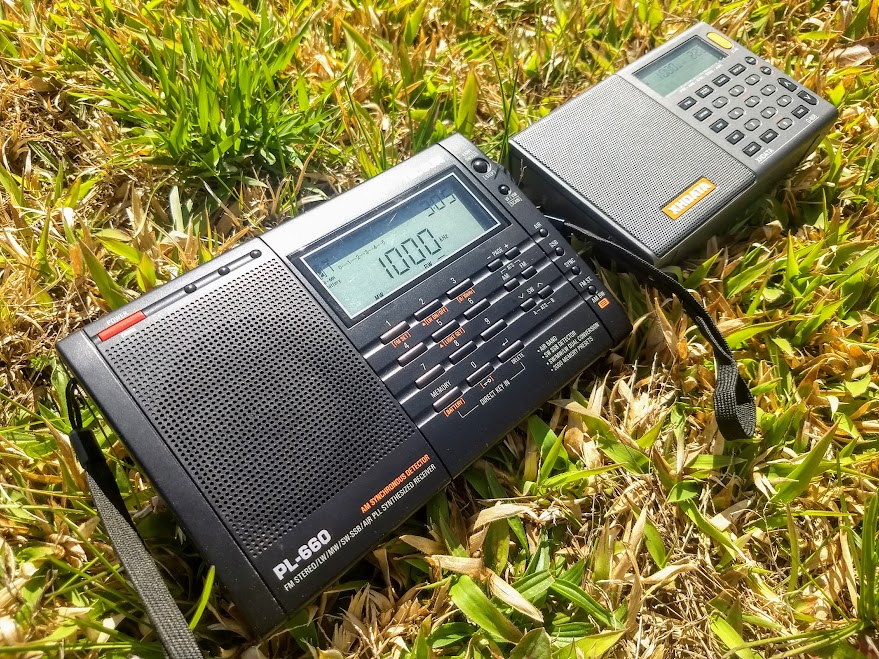

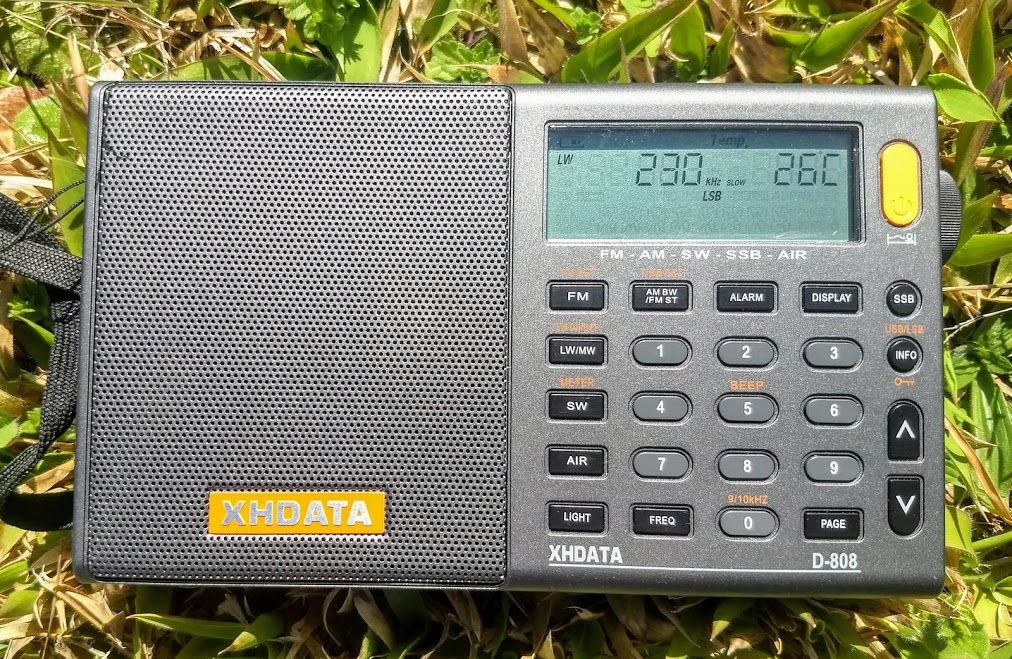
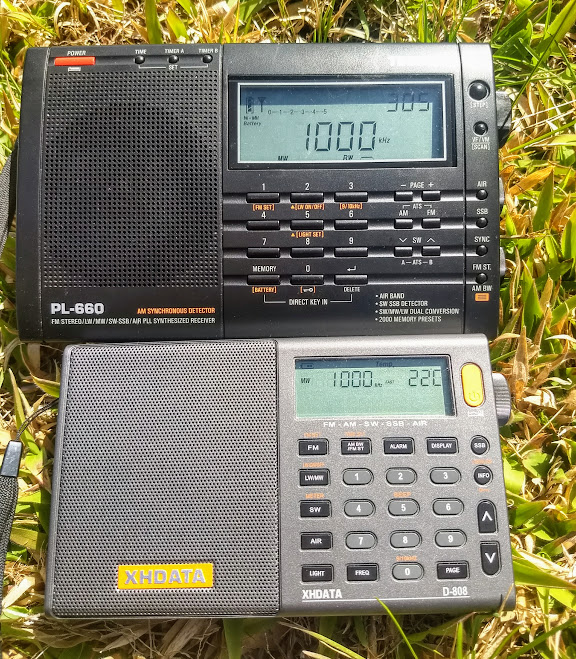
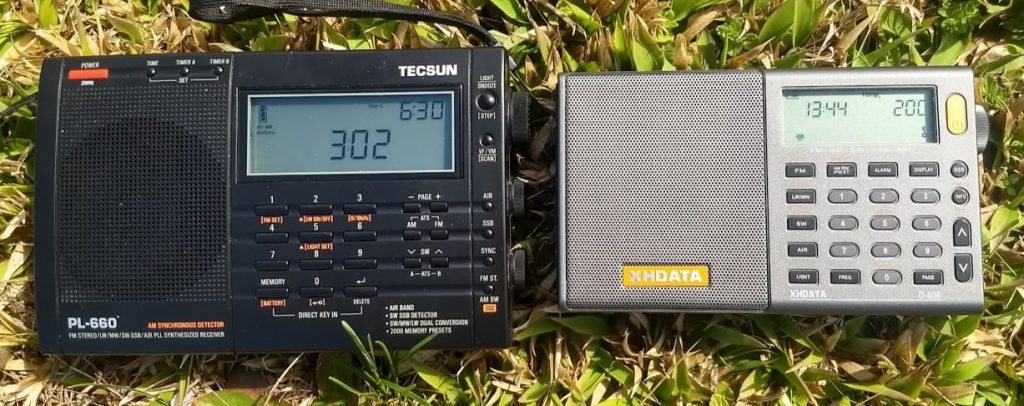

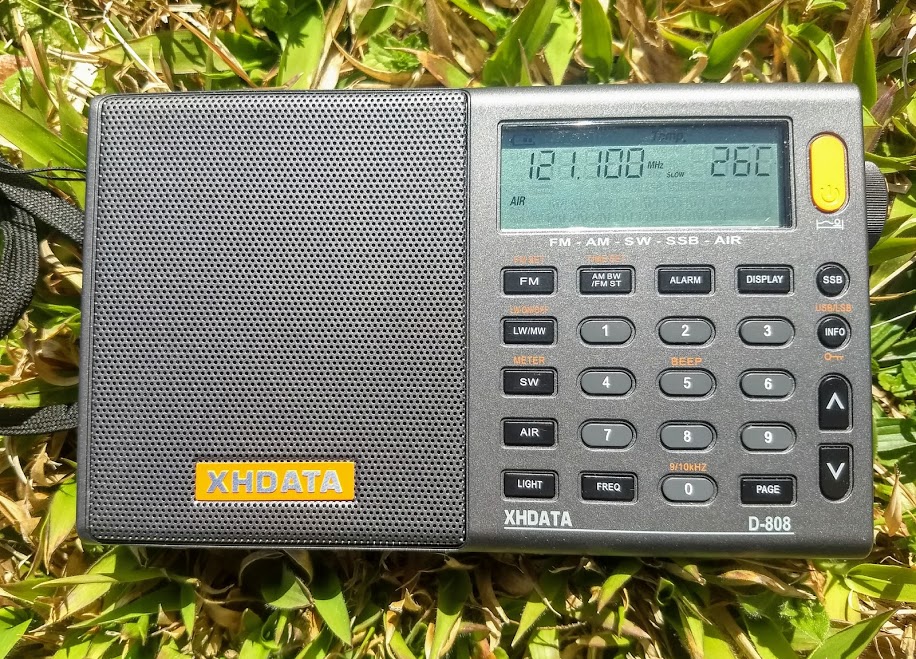
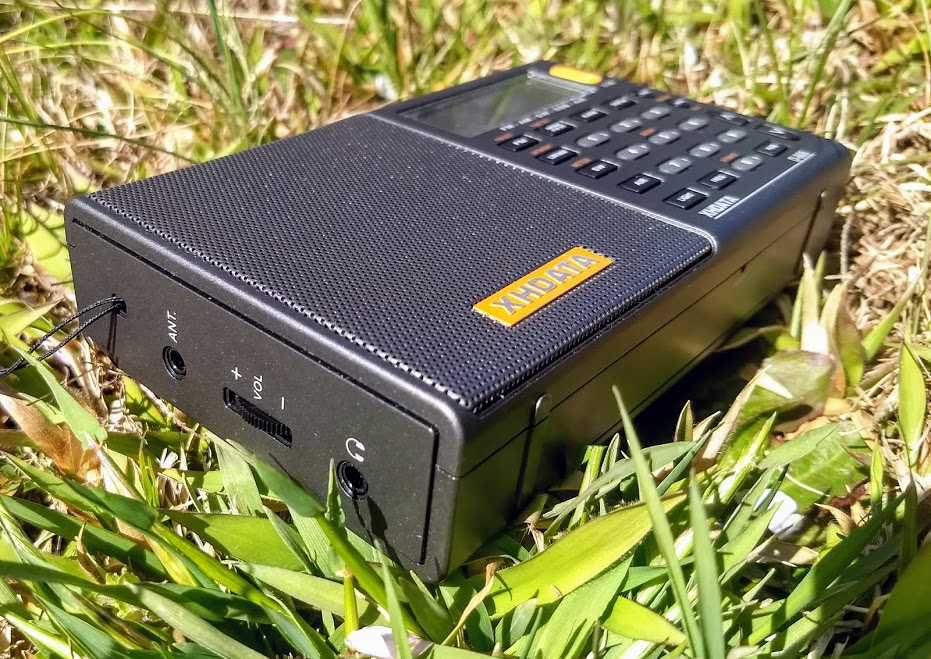
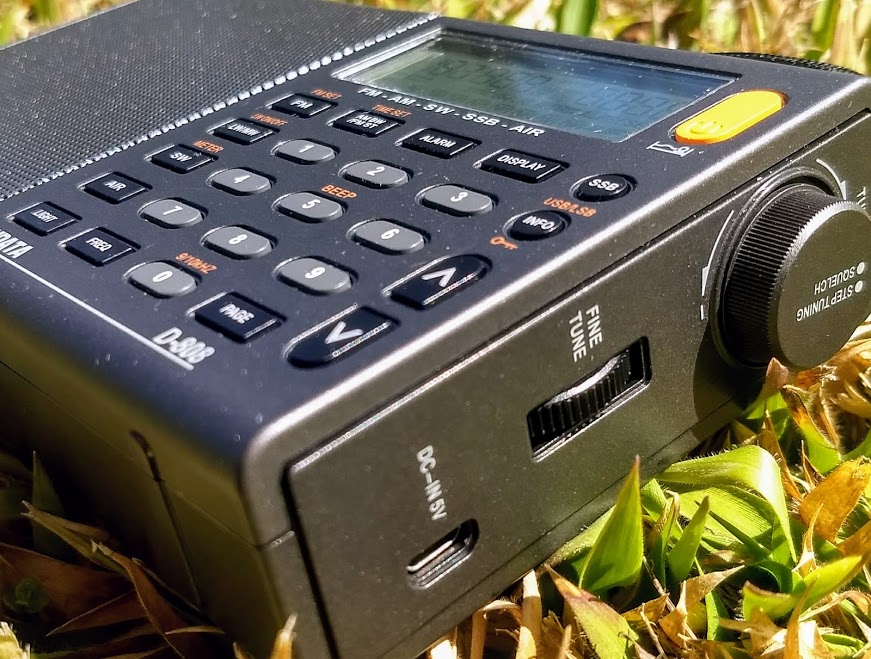
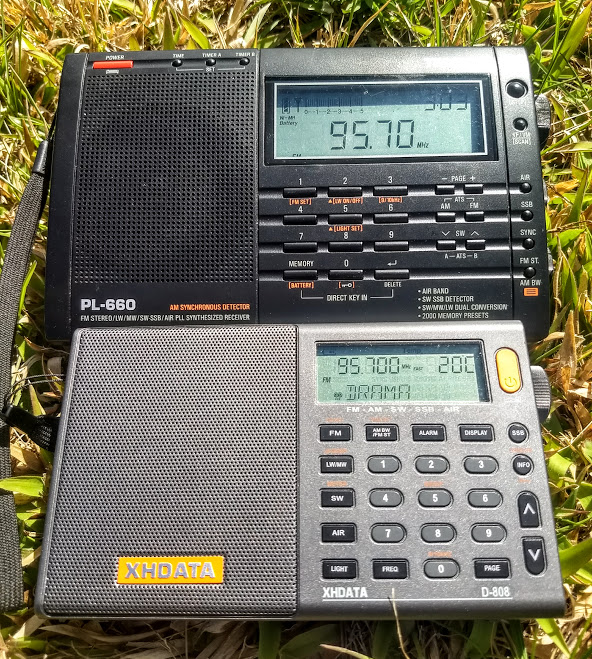
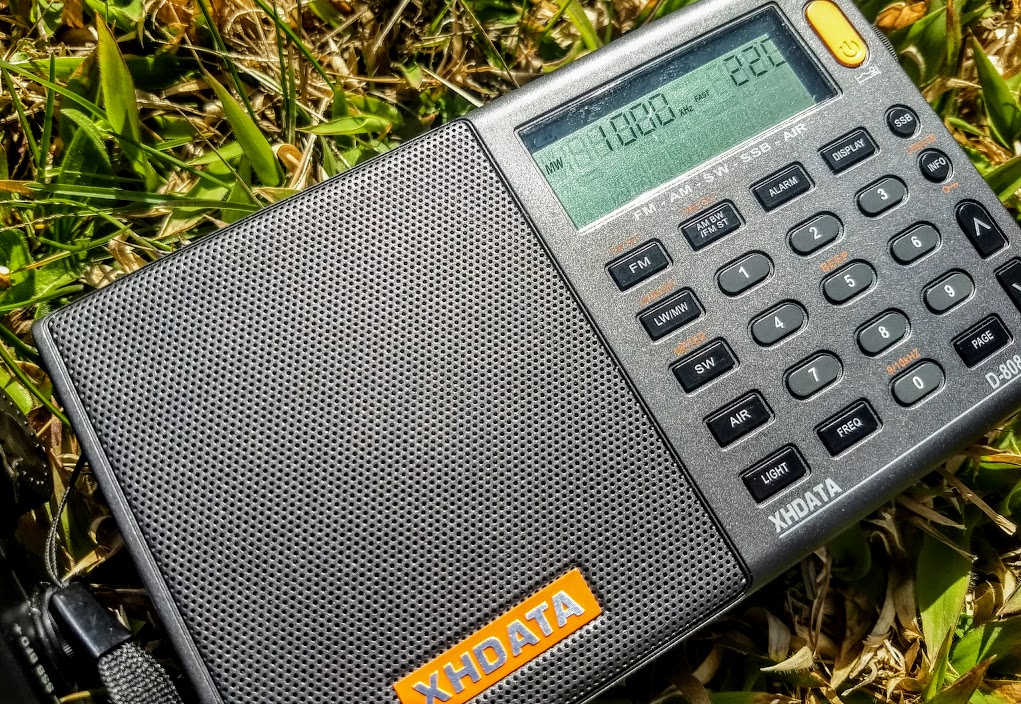
I have exactly the same problem of a permanent background noise. There are any way to solve this?
Considering FM reception I noticed that turning off a Desktop Computer placed in the same room suddenly let disappear all background hiss. I’m doing recordings from my XHDATA D-808 using my pcm-recorder LS-P4 from Olympus. I am happy to be able to listen to and record from at least 5 of the bigger stations in realtive noise-free condition. What’s also of use is turning off any bigger electric device, like tV sets or big stereo sets.
Has this radio gotten any updates to firmware or functioning since its initial release? I’m looking for a travel portable when I go out to the California coast later this year. And if not this radio, would the 680 be a better choice? I’m interested in stability, tuning, and switchable bandwidth.
Does anyone know if this has lvp for the battery? I know it comes with a button top but it doesn’t say in needs to be a protected battery. I wish more used 18650 batteries. Love mine looking at getting a cc crane 2e as a higher end one, anyone have both?
Hey, i just got my XHData D-808 from Amazon and when i go to the frequency 13mhz and then do a autoscan, it skips from around 13.99mhz to 15mhz.. so it isn’t scanning the whole 14mhz range. i have the same issue with 1-2 other frequency ranges. i do the scan not with the ATS scan but with the “up and down buttons”.. and it is skipping every time. is this normal? is there a fix for this? because its annoying to scroll through the whole 14-15mhz range.. i already sent a email to the support of XHData but they couldn’t really help me.
ATS works in the broadcast bands only.
i didn’t use the ATS. if you press the up / down button, it searches automatic for the next station / signal. i use this function.
Sorry, all simple automatic scanning works (and makes sense!) only in the broadcast bands with their fixed channel spacing (or generally in “channelized” bands).
damn, that sucks. i wanted to scan for HAM’s :/
XHDATA D-808 – (68.99) I briefly owned this one of these portable radios. Zero LW reception, zero Air band, SW & SSB were virtually non existent, battery even aftter a full charge didn’t last long. FM & MW ok.
My TESCO RAD-108 portable on the other hand picks up 4 or 5 LW late at night, some SW, FM & MW ok. batteries last ages, used for approx 1 hour /day. (£9.50)
Had an Eton digital SW portable a similar duff performance to the D-808 (approx £70)
In my experience a simple analogue portable wins every time.
Hello Dear Friends, I have a question on XHDATA D-808 preset scrolling possibility with the tuning knob or up and down buttons? I could not find any information about it either in the user manual or on the internet.
Thank you.
no, it will not scroll through presets using the knob or the up/down buttons
Ordered from Radiwow via AliExpress. Received 4 weeks later – upon power up the display was defective – every other line on the display was out. Also the battery charge level never registered. Swapped out batteries per their instructions – same results. Add in the poor customer service from AliExpress and this became one of the worst purchases that I’ve made in 30+ years of amateur radio. Sent them the photos and video evidence of the issues and they promptly resolved the issue by offering a $50 refund and I could keep the defective D-808. I asked them to issue a call tag so that I could send it back so that they could refund or replace the unit and I received another dispute resolution of $0 and then the case was closed. The only savings grace is that I used PayPal which is backed up by AMEX.
Hi, got an E-mail from XHData about Reviewing an 808 and getting one free. Must have heard I do honest reviews and build my own tennas. Anyone else get one of these offers ? I did respond with Yes. Have not heard nothing
I haven’t kept up with the latest models. Are there alternatives to the XHDATA D-808 in the same price range that also have narrow band filters?
The new 2020 — PL 330 is a good competitor.
Hi,
i bought XHDATA S808 just a week ago from amazon. in MW i am not getting below 522KHz, How to switch to LW in D808? pls advice.
Not sure if anyone has replied to this yet, or if you’ve found out – but while the radio is off press the LW/MW button and that will toggle LW on or off. Hope that helps and enjoy this amazing radio!
Hi, I have a radiwow R108 which is the designed and made by the same Xh-data company. I noticed that when I turned down the volume to the minimum, there is a hissing background noise present on all bands, (esp. on FM band where the noise is even louder…). I also heard that people with Xh-data 808 also have this problem. Is this normal? Is this due to the DSP design. Its quite annoying since I used it to listen to FM classical music, when at lower volumes, the noises is being played out together with the music…
I have exactly the same problem of a permanent background noise. There are any way to solve this?
i found this:
https://www.hamuniverse.com/speakernoisecircuit.html
the xhdatad-808 has a 8ohm 1w speaker.
i used two 10uF electrolytic polarized capacitors connected on the + side in series to make
a non-polarized capacitor of 5uF and a 10ohm 2w resistor.
the background noise did improve quite a bit by filtering the higher frequencies of the noise.
I have recently bought the xhdata D808. It has significant hiss at zero volume through headphones. Fortunately the hiss is constant and does not increase with volume.
I figured out below 2 solutions without opening up the radio.
Solution 1: Use a battery operated headphone amp. Keeping the volume on radio to moderate/high use the volume on headphone amp to reach desired level. This will completely eliminate the noise. This works because the audio signal to noise ratio increases so much with moderate volume that when you reduce the audio through the amp the noise levels become absolutely inaudible. I use FiiO Q1 amp which has a digitally stepping volume control which eliminates any stereo channel imbalance at low volume. This imbalance issue is also there in d808 because it has analog potentiometer vol. control.
I also use a Marantz PM5005 integrated amp to route audio to bookshelf speakers with great results, but all amps connected to ac supply will not work, they need to have very clean power supply so as to not introduce noise and signal interference.
Solution 2: Using a low sensitivity headphone like Sennheiser PX 90. But this will only reduce the hiss, not eliminate it completely.
Hello. I received the XHDATA D-808 today. A nice little radio. I am however wondering if anybody out there knows how to deactivate the Alarm function? The instruction manual is vague regarding this.
Any help on this matter would be very much appreciated.
Michael
When switching on the radio immediately, quickly press the POWER key and select to disable the alarm function.
No. That’s to turn of sleep timer.
To turn of alarm.
With the Radio OFF,
Long press alarm button,
Up or down tuning buttons toggles alarm beep, alarm, play radio, or alarm OFF.
With the Radio OFF,
Long press alarm button,
Up or down tuning buttons toggles alarm beep, alarm, play radio, or alarm OFF.
Thanks from Brasil for your detailed review. Your local of dx is paradisiac!
I have the XHdata D-808 and find it a good radio for the money, I have no issues with battery life and have left it for weeks without use and still plenty of battery life.
LW is poor, better than the PL-660 but still poor, Good on MW and Very good on SW. I hate the soft muting. It is a noisier radio than the PL-660 which is less fatiguing. But due to the differences in the audio/speaker sometimes the D-808 can be more intelligible on weak signals than the PL-880 or PL-660 and even the S8800.
The PL-660 is poor on LW and Deaf on MW great on SW and has great Sync Detection I wish other radios had, the wider filters can be an issue with SW DX’ing but changing to LSB/USB can make all the difference.
The PL-880 has the dreaded distortion on SSB which can be annoying, on the D-808 it’s hardly noticeable. The S-8800 suffers the same on SSB.
The PL-880 is decent on LW, Good on MW and very good on SW, it’s a joy to use. Audio is ok. I find the Audio on the PL-880 better to my ears in general.
The S-8800 is good on LW, MW and very good on SW. A nice radio, but the distortion on SSB at the beginning of a transmission is very annoying. I find most of the DSP radios noisier with a harsher sound than the PL-660.
The Antenna input on the S-8800 also works on LW/MW but does not disconnect the internal ferrite but once you’re aware of it it greatly improves lw/mw/sw with my Bonito MA205 Whip.
All these radios can overload easily at night with external antenna and so the local/DX button helps a lot, unfortunately the D-808 overload with external antenna can be quite a lot with no form of attenuation.
New Radios are few and far between these days and likely to get rarer with SDR becoming more common but as much as I like SDR I like to listen to radio without a computer and would like to see higher quality radios in the future.
I have both the D-808 and PL-660. I have to say my experience is contrary to some of the findings in this review. My PL-660 trounces the D-808 on LW. It’s not even close. Even at night here in the UK the D-808 struggles to get BBC Radio 4 on 198khz. Pretty much nothing else. The PL-660 pulls in all the main stations from Europe, some very strongly. On MW they’re both very similar, a slight edge to the PL-660. This amazed me because when I got the PL-660 the other day I was buying on the expectation that MW and LW were poor. A bonus!
The D-808 is a sensitivity monster on SW. With very weak and fading signals it has a slight edge on the PL-660. But if I can get the sync to engage without screeching the PL-660 can on occasions better the D-808 on this score. The D-808 really is good here. The audio is very intelligible with weak signals.
I do wonder if Tecsun have improved the PL-660 over the years. More than likely as most manufacturers make undocumented improvements over the years. The build quality is also very impressive, the buttons are as rattle free as they are on the D-808.
The review states the PL-660 doesn’t save bandwidth and other settings when storing in memory. Mine does. It stores USB/LSB, bandwidth and even Sync settings. Maybe this happened with later firmware versions.
Both fabulous radios. The D-808 is amazing for the money. The PL-660 is far better than I was anticipating given its performance on LW and MW.
I acquired the D808. The original battery or XHDATA 2000ma battery was at two bar mark instead of three bar full charge level. Recharged it. After using the radio.for a few hours for around two days the battery level has gone to two bar level. It is more than a week it remains at that level . I measured the current consumption when the radio is at sleep mode. On the 20ma range it showed 0.12ma. Quite a reasonable consumption. Even after seven nights, it is at two bar level. Not completely drained as experienced by some of our users.
-Partha VU2GPS
Battery life is a real pain in the ass. When I put a fully charged battery on it, (original or Panasonic ) in three days with no use at all it is dead. So you have to take battery out when not in use, or use an external battery always.
I think it is a big failure in its design
Jose, which radio are you referring to? The D-808 has a lithium pack–I don’t know of a Panasonic equivalent.
If you’re putting fully-charged, fresh AAs in the PL-660 and it’s burning through the batteries without even being turned on, then you most certainly have a faulty unit.
-Thomas
Thanks for the detailed review of the XHDATA D-808.
Has anyone here experienced this problem with the radio?
I have used two different kinds of batteries and I observe that the radio discharges the batteries very quickly, even when the radio is not in use. For example, I put in a fully charged battery and leave it inside the radio. The radio is turned off and the battery indicator shows the battery is fully charged. I then leave the radio OFF and the next day the battery indicator shows that the battery has about 50% of its charge, even though the radio has not been in use.
When I bought the radio, I purchased two (2) additional batteries (XHDATA 18650, 2000 mAh). I have tried with the 3 XHDATA batteries (the one that came with the radio and the two spare ones) and I have also tried with a Tecsun battery that I use with my Tecsun PL-880 radio. They all give the same result, excessive battery drain in sleep mode, which tells me that the problem is not with the batteries but with the radio.
I suppose one could take the battery out when the radio is not in use, but I have never had this problem with any other radio.
Thanks in advance for any thoughtful answers (I have contacted the seller, “radiwow”) and await a response.
I’ve read a similar comment in one of the other posts about the D-808, so it’s possible that a few units come with this issue. Are you using the proper unprotected 18650s with pin? Another thing to rule out as a potential culprit would be the charger, but I guess the 808 shouldn’t indicate a fully charged battery then. I hope you have no trouble getting the 808 replaced!
A few weeks ago I gave away the 808 tested here, so I ordered a new one which I should be getting today. I’m curious how that one performs. 🙂
Well first off, I didn’t charge it yet and it didn’t drain the battery visibly over night, but given that the battery indicator has only 3 bars this can be hard to spot. I also remembered having read some complaints about discharging batteries over night in Amazon reviews.
Secondly, this one is even more deaf on LW than the old one, it’s picking up sensitivity 100kHz higher around 400kHz, so the NDB band is deaf on this one too. Everything else seems just like the first unit tho. Well, this one might become subject to some modification attempts, but anyway it feels good to have this little bugger in the pocket again. 🙂
Thanks for your reply Ollie. I have now tried with three different kinds of batteries, all unprotected type, with the same results. It is definitely a problem with the radio draining the battery in sleep mode. Unfortunately, I contacted the seller (radiwow.com) and they replied that since no one else had complained about this, the best they could do is to let me test one of their future products, even after I asked to send the radio back to them and asked for a replacement. Needless to say, I won’t be doing business with them again.
If anyone has encountered this problem and solved it, I am all ears.
My D-808 has just started to flatten the batteries too. I did a check and it draws about 24ma until the backlight goes off and then current falls to 12.8mA and stays there. This is enough to flatten the supplied 1500mAH battery in about 5 days without any listening time.
Definitely a fault in the radio which is a shame because it’s a great piece of kit – unfortunately, it’s not going to be much good if I have to keep removing the battery every time I turn it off.
I’ll be looking for an alternative now and putting the D-808 in the ‘dead equipment’ drawer.
D
I’ve found that my battery operated drill battery pack contains numerous 18650 cells that work great in my Xhdata. They don’t have a nipple on the top + end but you can easily make it work. MIne charges right up in the radio.
Hi, I recently tested my newly bought D-808 near a part of the North Sea shore at Crail, Scotland and I was much impressed with the receiver’s sensitivity on FM and SW. Medium wave was great too. On Longwave I managed to get Radio 4 on 198khz ok but it struggled to get more distant stations. I too have a Pl660 and regard the D 808 to be a more sensitive pocket substitute for it.
Does the D-808 have a smooth tuning knob action with no detents? Also any soft muting? Thanks
Great review. Would be interesting if you tested them both with a passive MW loop as I find that the xhdata is rejecting signals rather then enhancing them and raising the noise floor, whereas the Tecsun pl-880 will accept the tuned passive loop.
Not sure how that Tecsun sounds though a pair of cans but the xhdata sounds great.
For the price alone the xhdata is worth every penny and is now my “go to” radio for travel…yes, even for a walk.
Very interesting review, thanks!
Could you describe sound quality oh headphones output? Is it suitable for FM music listening?
I’d say nothing unusual to hear on FM. The audio stage has a distinct noise floor that gets better with (I guess) increasing headphone impedance. It’s certainly suitable for FM music listening… in Germany that is! I don’t know how it copes with the extreme FM deviation e.g. in France or the Netherlands tho.
not so good compared to G6 aviator from eton,,,, The fidelity part is missing in D808 and sounds less treble!!!
I tested my D-808 with the low impedance AKG K240. There is low dB hiss even if you turn the volume all the way down. When you turn the volume up to 5%, you can still hear the hissing. In FM mode, this low noise is more noticeable. However, this hiss is not heard above 10% of the sound.
In FM mode the stereo separation was very successful, I was able to get quite full and satisfying listening. In other bands, the speaker on the D-808 seems to deliver a more frequency-oriented sound. I guess this happens because the speaker on the D-808 cuts out some the frequencies.
Despite everything, the D-808 managed to drive a half-open headphone without the need for a headphone amp. I’m going to try a headphone amp this weekend. I’ll update my review if my thoughts change.
Thanks for the great review of the D808. As an owner of a PL-660, the comparison is especially interesting. Also, it’s interesting that the D808 is worse than the PL-660 on LW below 300 MHz but better above.
They could have made the buttons a bit taller. In the dark, it is impossible to get a tactile location of the buttons which makes it difficult to use in unlighted areas. The audio is something to improve, a better speaker. I solved this by using a PC speaker which sounds so much better. The one drawback it is missing band range between 450 Khz and 500 Khz . this will not be missed by most but I use it for troubleshooting radio IF’s which make this not suitable .
Great review. Thank you!
The battery is a deal breaker for me though. I prefer to have radios that can take alkaline batteries when needed. I love my PL-880 but if I get in a bind I can’t just run into a Wallymart and get spares.
13dka, I wish you would review every radio that comes out.
I love this detailed, thorough, and quite balanced review. Thanks for all your efforts!
So, If D-808 cannot hear a thing on LW, and PL-660 is mediocre… what would you suggest for LW DXing?
As far as portables go, I would say a Sony 7600GR, but Sony just discontinued it. If you can find the pre-DSP version of the Kaito 1103, that’s close to the Sony on LW. Also, I’ve seen reviews stating that the Sangean 909X is pretty good on LW.
Has anyone compared the Digitech AR-1780 with the XHDATA D-808 on LW?
Jim, thank you for your suggestions. I had Degen1103 but sold it – it had encoder problems. I wish I knew it is that good on LW. Sangean is way to much expensive. I’ll try to find 7600GR then.
I was hoping that something easily obtainable in Europe might be good for LW DXing.
Good question. I guess you mean what portable I’d suggest and I’m afraid I can’t answer this – many of the best performers on LW are probably vintage radios, even though this is about MW, not LW you could check https://radiojayallen.com/am-portables-mega-shootout-2016-update/ to get an idea.
However you asked for “LW DXing” and that could require more effort than you expect, depending on your location and your expectations. Mind you, even if you’re in Europe there are not many stations anymore and the remaining ones are prone to get closed as well sooner or later. The likelihood of catching real (e.g. transoceanic) DX is probably next to zero with just a portable.
You saddened me. I still remember back in 80/90 how crowded it was on a dial.
Maybe I should look for DIY LW receiver to have real LW experience, hi! If you guys know one -please let me know! For now I bought second hand 7600GR (caps replacement neeeded since it is deaf).
Although the number of LW broadcast stations is dwindling, there are plenty of NDBs to catch – as well as hams on the new 630 meter band.
Also, whatever portable you’re using, a good loop antenna will greatly enhance your chances for hearing longwave DX. My ham/DX friend (and SWling contributor) RTC turned me on to the 14” PK loop LW antenna, and it has really changed the game for me. For example, in November 2016 I heard France Inter on 162 kHz here in San Antonio, TX, using just my Sony 7600GR and the PK loop.
Terrific review, one feature is missing on the D808 and that’s memories scroll.
I suggested the manufacture to have the UP/DOWN keys to scroll memories if the knob is at stop mode. Don’t you think it’s make sense?
I’m totaly agree with this comment and the 808 is by far now my favorite holiday radio because it’s size and possibility’s. I’m also using it in my house next to my Yeasu and Kenwood rigs and even more than my 660. MW is very good and FM (with OIRT band) with quick RDS detection is a good option. Airband is good enough versus 660 is deaf on that band. HF is ok / good for rx on Ham bands and other radio stations. The 660 is very nice to tune but the 808 is with some try outs good enough to tune on the right band and modulation. The filters are nice and on Airband is (for me) with the small speaker and more higher sound better to hear the conversion. You can’t compare it with expensive other radio’s (however it’s a good score versus the more expensive 660) and every radio and antenne is a compromise, but: For the price, the possibilitys and it’s weight it’s for me a very good price versus quality combination. Have fun with it! Kees PA3GHQ
Outstanding, detailed review. I really don’t think it has left much of any question unanswered.
I love reading a well-prepared review of shortwave radios especially those of multiband portables with SW. This comparative review of the D-808 and the PL-660 is outstanding.
Most of my radio listening of late is done with a Sangean ATS-909X (2015), Eton Grundig Edition Satellit (2017) and Hammarlund SP-600 JX-21 (1957). None of these radios is pocket-sized (especially the SP-600). I do all of my SW listening with external wire antennas. Of these three radios I use the 909X or the SP-600 most often for shortwave broadcasting. The SP-600 is the clear SW winner of the two and the 909X is my best SW portable. I much prefer the selectivity of the 909X with its two MuRata ceramic IF filters to the DSP bandwidth filters on the Eton. SP-600 selectivity blows them both out of the water. The 909X has an actual RF gain control like the SP-600. I love that. For the AM broadcast band I like the 909X. I can rotate the 909X and its ferrite bar antenna for MW. For FM the 909X runs circles around the Eton. My favorite of the three for SSB and ECSS operation on SW broadcasts is the Eton with its 10 Hz resolution. The Eton is my only air band radio and I’m happy with it. I don’t spend much time on LW.
After reading this review I will have my eye on the D-808 if I should ever want a pocket-sized SW radio. However, I’m not sure how I will use this radio from my shirt pocket with the telescopic whip extended. Right now I’m listening to birds on my walks.
This review pretty much sums up my experience with the XHDATA D-808. I think this radio has been overhyped lately because of its very low price. The build quality is not that great. On my unit the volume knob became scratchy after only one month of use. It’s a good radio for $64 but nothing more.
I initially considered this radio and its evil Digitech twin from Australia, but the subsequent reviews leave me less than enthused. With major dealers periodically having “fire sale” prices on the Eton Satellit, it would seem that the extra 30 USD spent is a better investment – provided you “get a good one”.
Might I ask why you refer to the Digitech as evil?
Curiosity got the better of me and I ended up buying all three (the Digitech AR170, the XHDATA D-808, and the C.Crane Skywave SSB) to compare and other than minor feature differences, I find them all roughly equivalent in terms of sensitivity and selectivity.
You’re right though, for the money, the Eton “Grundig Edition” Satellit is much more capable and it gets my recommendation. What an amazing radio!
Is this a knockoff of the CCrane SSB but with an external antenna jack and poor AGC? It would make for an interesting comparison. I am still waiting for CCrane to fix that model’s bugs before I try ordering again!